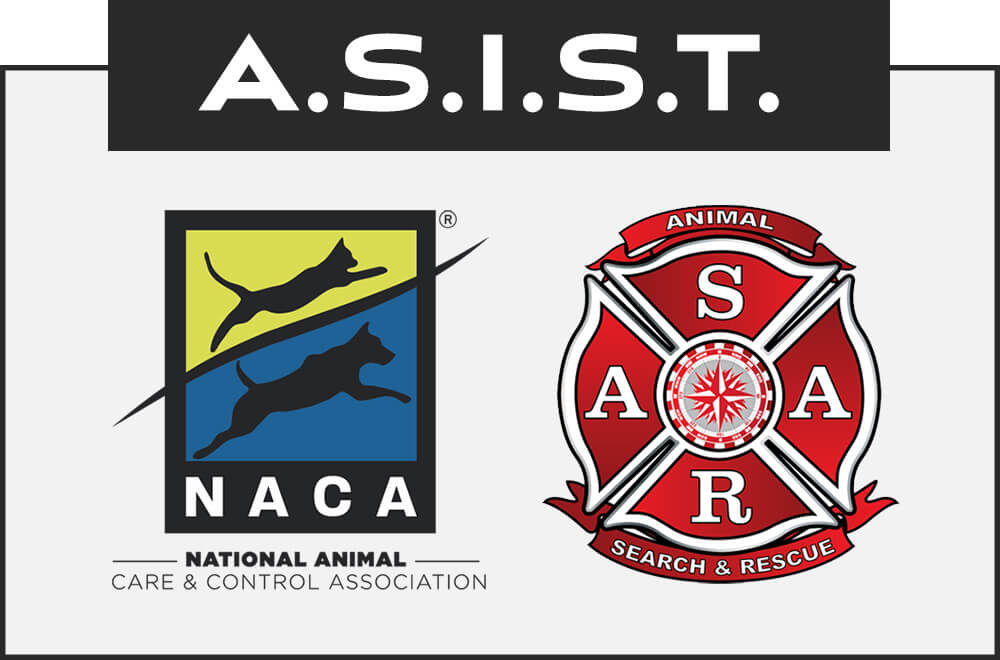A.S.I.S.T.
Animal Services Incident Support Team
Strengthening Animal Rescue in Disasters
NACA Login Required
When disasters strike, the safety of animals and their communities depends on rapid, coordinated action. ASIST was created to provide that support.
A joint initiative between the National Animal Care & Control Association (NACA) and Animal Search and Rescue (ASAR), ASIST is designed to enhance animal-related disaster response nationwide. From pre-incident planning to boots-on-the-ground deployment, ASIST ensures Animal Control Units have the tools, training, and support they need to respond quickly and effectively.
Mission
“When disaster strikes, we stand united—no agency, no community, and no animal faces it alone.”
ASIST offers professional, no-cost assistance to agencies of all sizes—whether in the field or within Emergency Operations Centers. From coordinating animal evacuations to supporting recovery operations, ASIST stands by responders every step of the way.
Q & A
Training Delivery
Will the ASIST training be in-person, virtual, or hybrid?
Is this a rolling enrollment or cohort-based?
How often will core ASIST trainings be delivered?
Who delivers the training: NACA instructors, ASAR leads, or a shared team?
Will there be refresher trainings or continuing education requirements?
Requirements & Mandates
Will ASIST certification be mandatory to deploy?
Will deployments only include trained ASIST members, or can affiliates assist in certain roles?
Will ASIST training be required for all NACA members, or optional as a specialty unit?
Will ASIST members need to recertify (e.g., every 2–3 years)?
What baseline qualifications must someone meet to enroll (e.g., FEMA ICS courses, ACO certification)?
Membership & Affiliation
Do ASIST participants need to be active NACA members?
Will there be a separate ASIST membership tier or dues?
Is ASIST open to shelter staff, vet techs, volunteers, or only sworn officers? Humane officers?
Will ASIST members get special ID, badges, uniforms, or a member portal?
Operational Readiness
How will we verify readiness for deployment? (e.g., gear checklist, self-assessment, supervisor sign-off)
Who decides when and where ASIST deploys? (Triggering criteria, call tree, decision chain)
How will we verify readiness for deployment? (e.g., gear checklist, self-assessment, supervisor sign-off)
How will deployment be requested?
An ASAR MOU is preferred ahead of deployment so the requesting agency understands deployment details during “blue skies” and not in the middle of a disaster. To start the MOU process, email ethompson@asartrainig.com. There is no cost to have an MOU. An agency that is requesting ASIST deployment will need to confirm the request has been approved by their agency leadership, and that agency needs to be in contact with their Emergency Management to communicate the request has been made. Requests can be sent to jowen@nacanet.org or ethompson@asartraining.com. If an agency is in the path of a “known event”, we encourage the agency to lean forward and send an email with intent to activate ASIST resources. That gives resource coordinators additional time to line up responders and resources.
How long does it take for ASIST resources to arrive?
Will deployment be in-person or virtual?
Who pays my expenses if deployed in-person?
Will deployment be in-person or virtual?
Is deployment paid or volunteer?
Communications & Community
How will you keep ASIST members informed?
Will there be an annual ASIST member summit or networking event?
Will deployed responders receive debriefs, recognition, or peer support after events?


